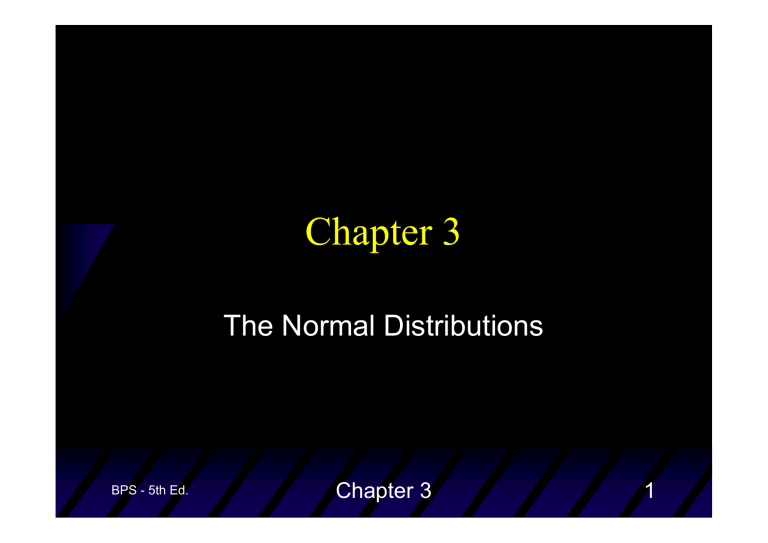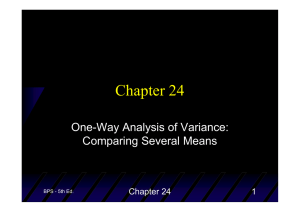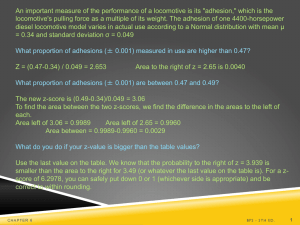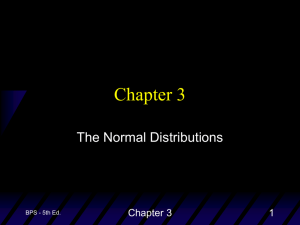Chapter 3 The Normal Distributions 1 BPS - 5th Ed.

BPS - 5th Ed.
Chapter 3
The Normal Distributions
Chapter 3 1
More on Histogram
BPS - 5th Ed.
Chapter 3 2
More on Histogram
BPS - 5th Ed.
Chapter 3 3
Density Curves
Example : here is a histogram of vocabulary scores of 947 seventh graders.
The smooth curve drawn over the histogram is a mathematical model for the distribution.
BPS - 5th Ed.
Chapter 3 4
Density Curves
Example : the areas of the shaded bars in this histogram represent the proportion of scores in the observed data that are less than or equal to
6.0. This proportion is equal to 0.303.
BPS - 5th Ed.
Chapter 3 5
Density Curves
Example : now the area under the smooth curve to the left of 6.0 is shaded. If the scale is adjusted so the total area under the curve is exactly 1, then this curve is called a density curve .
The proportion of the area to the left of 6.0 is now equal to 0.293.
BPS - 5th Ed.
Chapter 3 6
Density Curves
X Always on or above the horizontal axis
X Have area exactly 1 underneath curve
X Area under the curve and above any range of values is the proportion of all observations that fall in that range
BPS - 5th Ed.
Chapter 3 7
Density Curves
X The median of a density curve is the equal-areas point, the point that divides the area under the curve in half
X The mean of a density curve is the balance point, at which the curve would balance if made of solid material
BPS - 5th Ed.
Chapter 3 8
Density Curves
X The mean and standard deviation computed from actual observations x s , respectively.
X The mean and standard deviation of the actual distribution represented by the density curve are denoted by µ (“mu”) and
σ
(“sigma”), respectively.
BPS - 5th Ed.
Chapter 3 9
Question
Data sets consisting of physical measurements
(heights, weights, lengths of bones, and so on) for adults of the same species and sex tend to follow a similar pattern. The pattern is that most individuals are clumped around the average, with numbers decreasing the farther values are from the average in either direction. Describe what shape a histogram (or density curve) of such measurements would have.
BPS - 5th Ed.
Chapter 3 10
Bell-Shaped Curve:
The Normal Distribution
BPS - 5th Ed.
mean standard deviation
Chapter 3 11
The Normal Distribution
(
Knowing the mean ( µ ) and standard deviation
σ
) allows us to make various conclusions about Normal distributions. Notation: N( µ ,
σ
) .
BPS - 5th Ed.
Chapter 3 12
68-95-99.7 Rule for
Any Normal Curve
X 68% of the observations fall within one standard deviation of the mean
X 95% of the observations fall within two standard deviations of the mean
X 99.7% of the observations fall within three standard deviations of the mean
BPS - 5th Ed.
Chapter 3 13
68-95-99.7 Rule for
Any Normal Curve
68%
-
σ
µ +
σ
BPS - 5th Ed.
-3
σ
-2
σ
95%
µ +2
σ
99.7%
µ +3
σ
Chapter 3 14
68-95-99.7 Rule for
Any Normal Curve
BPS - 5th Ed.
Chapter 3 15
Health and Nutrition Examination
Study of 1976-1980
X Heights of adult men, aged 18-24
– mean: 70.0 inches
– standard deviation: 2.8 inches
– heights follow a normal distribution, so we have that heights of men are N(70, 2.8).
BPS - 5th Ed.
Chapter 3 16
Health and Nutrition Examination
Study of 1976-1980
X 68-95-99.7 Rule for men’s heights
68% are between 67.2 and 72.8 inches
[ µ
± σ
= 70.0
±
2.8 ]
95% are between 64.4 and 75.6 inches
[ µ
±
2
σ
= 70.0
±
2(2.8) = 70.0
±
5.6 ]
99.7% are between 61.6 and 78.4 inches
[ µ
±
3
σ
= 70.0
±
3(2.8) = 70.0
±
8.4 ]
BPS - 5th Ed.
Chapter 3 17
Health and Nutrition Examination
Study of 1976-1980
X What proportion of men are less than
72.8 inches tall?
68%
(by 68-95-99.7 Rule)
16% ?
-1 +1
? = 84%
70 72.8
(height values)
Chapter 3 18 BPS - 5th Ed.
Health and Nutrition Examination
Study of 1976-1980
X What proportion of men are less than
68 inches tall?
?
68 70
(height values)
How many standard deviations is 68 from 70?
BPS - 5th Ed.
Chapter 3 19
Standard Normal Distribution
X The standard Normal distribution is the Normal distribution with mean 0 and standard deviation 1:
N(0,1) .
X If a variable x has any Normal distribution with mean
µ and standard deviation
σ
[ x ~ N( µ ,
σ
) ], then the following standardized variable (standardized score) has the standard Normal distribution: z
= x
−
σ
μ
Chapter 3 20 BPS - 5th Ed.
Standardized Scores
X How many standard deviations is 68 from 70?
X standardized score =
(observed value minus mean) / (std dev)
X
[ = (68
−
70) / 2.8 =
−
0.71 ]
The value 68 is 0.71 standard deviations below the mean 70.
BPS - 5th Ed.
Chapter 3 21
Health and Nutrition Examination
Study of 1976-1980
X What proportion of men are less than
68 inches tall?
BPS - 5th Ed.
?
68 70
(height values)
-0.71 0 (standardized values)
Chapter 3 22
Table A:
Standard Normal Probabilities
X See pages 690-691 in text for Table A.
(the “Standard Normal Table” )
X Look up the closest standardized score
( z ) in the table.
X Find the probability (area) to the left of the standardized score.
BPS - 5th Ed.
Chapter 3 23
Table A:
Standard Normal Probabilities
BPS - 5th Ed.
Chapter 3 24
Table A:
Standard Normal Probabilities z
−
0.8
−
0.7
−
0.6
.00
.2119
.2420
.2743
.01
.2090
.2389
.2709
.02
.2061
.2358
.2676
BPS - 5th Ed.
Chapter 3 25
Health and Nutrition Examination
Study of 1976-1980
X What proportion of men are less than
68 inches tall?
BPS - 5th Ed.
.2389
68 70
(height values)
-0.71 0 (standardized values)
Chapter 3 26
Health and Nutrition Examination
Study of 1976-1980
X What proportion of men are greater than
68 inches tall?
BPS - 5th Ed.
.2389
1
−
.2389 =
.7611
68 70
(height values)
-0.71 0 (standardized values)
Chapter 3 27
Health and Nutrition Examination
Study of 1976-1980
X How tall must a man be to place in the lower 10% for men aged 18 to 24?
BPS - 5th Ed.
.10
? 70
(height values)
Chapter 3 28
Table A:
Standard Normal Probabilities
X See pages 690-691 in text for Table A.
X Look up the closest probability (to .10 here) in the table.
X Find the corresponding standardized score .
X The value you seek is that many standard deviations from the mean.
BPS - 5th Ed.
Chapter 3 29
Table A:
Standard Normal Probabilities z
−
1.3
−
1.2
−
1.1
.07
.0853
.1020
.1210
.08
.0838
.1003
.1190
.09
.0823
.0985
.1170
BPS - 5th Ed.
Chapter 3 30
Health and Nutrition Examination
Study of 1976-1980
X How tall must a man be to place in the lower 10% for men aged 18 to 24?
BPS - 5th Ed.
.10
? 70
(height values)
-1.28 0 (standardized values)
Chapter 3 31
Observed Value for a
Standardized Score
X Need to “unstandardize” the z-score to find the observed value ( x ) : z
=
x
−
σ
μ
x
μ
z
σ
X observed value = mean plus [(standardized score)
×
(std dev)]
Chapter 3 32 BPS - 5th Ed.
Observed Value for a
Standardized Score
X observed value = mean plus [(standardized score)
×
= 70 + [(
−
1.28 )
×
(2.8)]
= 70 + (
−
3.58) = 66.42
(std dev)]
X A man would have to be approximately
66.42 inches tall or less to place in the lower 10% of all men in the population.
BPS - 5th Ed.
Chapter 3 33






